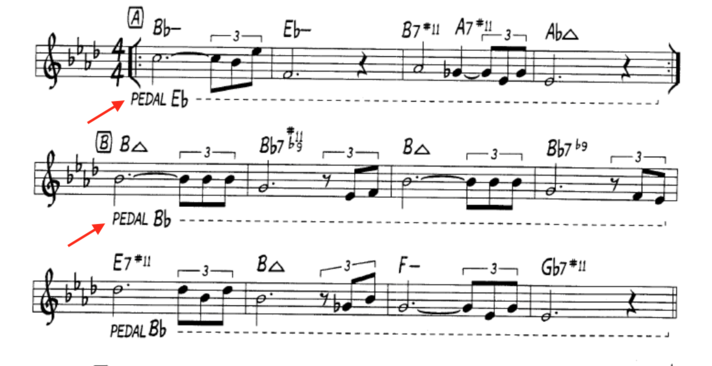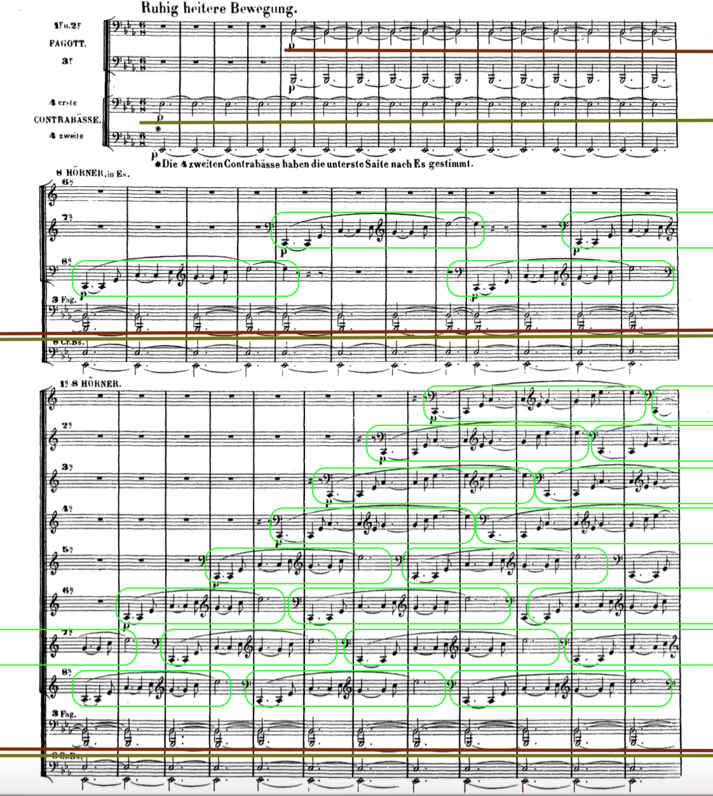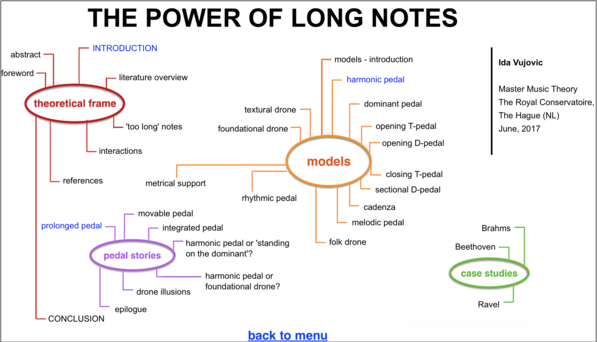Textural Drone: Drone As A Layer
In any musical style, sustained sounds are, by definition, textural layers. However, in many cases, tonal issues de-value the importance of their sound. This is true for all the harmonic pedals. The implicative strength of the dominant-pedal shadows the effect of its pure sound: the informed listener (or a music theorist) will most likely emphasize the power of harmonic function, possibly adding a note about the timbre. This means that all the tonic and the dominant pedals in music with functional harmony will be perceived primarily as harmonic pedals. In tonal/modal music with non-functional harmony, tonic-pedals will probably be perceived as foundational drones. It seems that there is a certain hierarchy of ‘default’ types. In tonal music, thus, in low registers, only the pedals on weak harmonic functions could be perceived as textural drones. Less limitations are imposed on the higher register. Typical textural drones are hosted in music where pitch is not the primary parameter.
Textural drone refers to a relatively stable line in the texture, to a rather constant sound amidst the other lines and music events. The sound is essential property of a textural drone. Its pitch can be any.
Tangerine Dream, The Birth Of Liquid Plejades
Drone music, is a style based on long sounds with little changes. In some sense, it can have a similar effect as repetitive music. The sound itself is an acoustic event, and it can be superimposed with other sounds, or it can undergo various (slow) changes. Many contemporary sound-art works could be said to feature textural drones.
Carl Michael von Hausswolff, The Sleeper in the Valley (opening)
In the ’70 of the 20th century, drones were especially loved. On one side, this was influenced by Indian music (Terry Riley, La Monte Young, Charlemagne Palestine), on the other side by the possibilities of the electronic studio. Ligeti was also acquainted with it in the time he composed Lontano. Lontano is born from a simple sound of one tone. This sound grows big (other tones join in), it changes, has its ups and its downs, experiences different phases in its life, then, slowly comes to its end. The piece could be experienced as a continuous transformation of a sound mass. In fact, these drones are just beautiful illusions. Both Lontano and its ‘sister piece’ Lux Aeterna are written in sections based on canons. Although some notes are quite long, there are no real drones.[1] The ‘micropolyphony’ (as Ligeti himself names it) creates the illusion that certain pitches are sustained as sound-layers or textural drones. This issue is discussed in Pedal Story ‘Drone Illusions’.
Charlemagne Palestine, Schlingen Blängen
Schlingen Blängen (1979) of Charlemagne Palestine could be described as a perambulation through sonic landscapes. Long drones creating a full, rather static sound, change slowly in the course of the development of a piece. Meaningless when reduced into classical musical notation, their effect lays in the subtle changes of all the aspects of timbre and texture. Palestine says in an interview that his music is at the same time minimal (long durations) and maximal (dense with sound), but that it is actually the trance that matters.[2] La Monte Young and his Theater Of Eternal Music (with Tony Conrad, John Cale, Jon Hassell, Terry Riley and others) “developed a music made of semi-stationary waves, of slowly evolving amorphous sound. Music became a living organism.”[3]
The composition that is often referred to as ‘the drone piece of classical music’ is the prelude for Wagner’s Das Rheingold. The perfect fifth, Eb-Bb, is held in low register for 113 bars (approximately 4:30 minutes). The Nature-motif is imitated in many voices above it. The motif itself consists of the notes of the Eb-major triad, which means that the whole prelude is based on one single chord - naturally felt as the tonic. All the musical events are thus harmonically united, there is no conflict. In this situation, the pitch is not the element that ‘tells the story’. The most dynamic parameter is the texture. The piece opens with the low drone Eb solo; the fifth comes a bit later. The Nature-motif presents the 1st, 2nd, 3rd, 4th, 5th, 7th, and 9th harmonics of Eb (counted from the fundamental). The voices that bring it are organized in gradually higher registers. But the drone is deep on the bottom, and it competes the optimism of the other events, adding a shiver. The drone stands out as a low textural layer. It opposes the other events (the whole network of Nature-motif imitations) by its immobility, its firmness. The imitations of the motif are at first clearly separated, and later in gradually closer stretti. The motif itself develops, including a couple of other pitches (as ornaments of the triad). The dynamics is increasing. The density of the texture is growing, and this incites tension. The drone still growls in the deep.
Even harmonic pedals could turn into drones. In the introduction to the chapter Harmonic pedal, I have mentioned Tchaikovsky’s 6th symphony, 2nd movement, where the pedal on the mediant slowly becomes (also) a textural drone. All sounding harmonic pedals are also layers in the texture. The pedal-ness and the drone-ness of any instance of harmonic pedal seem to be complementary in the way that the more of one will imply the less of the other. When the balance between the pedal-ness and the drone-ness of a pedal is not stable, the identity of this sustained sound alternates between being a pedal and being a drone. This is described in the two case studies, in the chapters on Brahms’s A German Requiem and Ravel’s Le Gibet. In this chapter, a short focus on John Coltane’s Naima will illustrate the case.
The song features two pedal tones in the bass (indicated in the score): Eb in the a section and Bb in the b section (of aba form). Although the key signature suggests these two are the dominants of the Ab major and Eb major key, this is not entirely the perceived harmonic meaning. When listening to this song for the first time, the power of the bass-tone roots the Eb, and absorbs the chord-notes in itself. The second chord (Ebm7) ‘justifies’ the existence of the Eb in the bass, and confirms it as a temporary foundation. At least temporary, Eb feels as the tonic. Further chord changes take the listener in another direction. In b section, Bb starts as the dominant pitch but slowly, its harmonic power is weakening (especially during piano solo).
While the song is unfolding, the listener becomes aware of the recurring rhythmic pattern in the bass. Any repetition is a grouping actor, and any perceived grouping will contribute to the interpretation of the whole. The rhythmic ostinato of the pedal emerges as a salient quality of this bass tone. In the moments when the harmonic implicativeness of the bass-tone is weak, the clearness of the rhythmic ostinato on the sustained pitch could lead the listener to feel the textural layer, a non-harmonic drone. As the song progresses, the listener gets used to the invariability of the pedal (within each section); its drone-ness increases. The pedal causes a light ‘modal feel’ of the music. At moments, the chord changes project the harmonic meaning on the pedal, which returns its pedal-ness. The two identities are the two sides of the same coin.
Let us shortly reflect on Ralph Vaughan Williams’ The Lark Ascending, to examine the birth of another textural drone in a tonal musical piece. The melody (solo violin) unfolds above a vague layer of pitch-threads. The piece is scored with one sharp in the key signature; the sound suggests B minor-pentatonic scale. The pitch-content of the accompanying layer is B minor chord, above low E in the bass. All the notes are sustained for a longer period. The element that is probably most responsible for the vague sound of this accompaniment is the E in the bass. The melody is in a cooperative interaction with the B-minor triad: together they suggest B as the tonal center. The low E is, by its position (played within the string section), a part of the accompanying pattern. Being the bass tone, it has strong harmonic implications. However, the cooperation of other actors wins the harmonic conflict, and establishes the tonal center for which the E is neither the tonic, nor the dominant. Another actor is pentatonic mode, the sort of tonal organization with weak harmonic forces. Together with the ambiguous harmony of the accompanying layer, it diminishes the importance of defining the harmonic function. For the listener, it means that the solo-melody (anyway more prominent) is paired with that what is ‘cooperative’, suppressing the harmonic meaning of E and so transforming the E-event from pitch to sound. However, the E-event is not only being changed through interaction, it also changes other actors in the assemblage. As a part of the accompanying group, the sonorous-bass E brings the sonority of the rest of the group to fore. The result is a separation between the melody and the accompaniment. The sustained notes are becoming a complex sonorous drone, and the rather independent melody is safe to fly: the lark can ascend.
However, it turns out that the relationship between the lark and the drone (morass under the sky?) is more complex than that. Although I have ‘degraded’ the accompaniment to a sound in the background, and although the lark is high in the sky, the real ties become clear when the drone stops.
Let me conclude with what could be called a ‘thundering pedal’, a kind of a hybrid of foundational and textural-drone.I am referring here to the vocal drones in tribal music, that are sung by the whole tribe, while the chief sings the melody. The sonorous function of drone in tribal music is already indicated by the various names it has in folk traditions. On Solomon Islands, it is said that the first voice ‘opens’, the second ‘follows’, and the drone ‘growls’.[4] Other associations are of a mythological nature. The pearl divers’ songs of Arab world are important examples. The repertoire includes numerous song genres, related to various aspects of pearl diving. The themes include pleas for protection from the dangers of the sea, for obtaining the navigational knowledge, and other issues. The songs tend to be rhythmically complex, with hand clapping and other percussion instruments. The singing is opened and led by a vocal soloist, against a low-pitched vocal drone maintained by the rest of the ensemble. This very characteristic feature, a bass vocal drone, is symbolically related to the voice of the whale – a sonorous association.[5]
Proceed to conclusion or, go back to the home page for the links to pedal stories and case studies.


